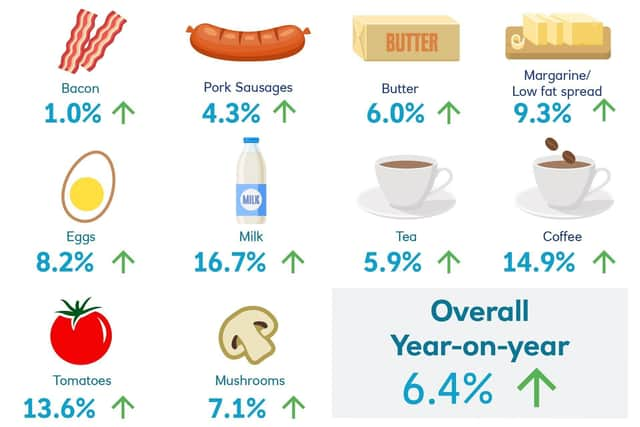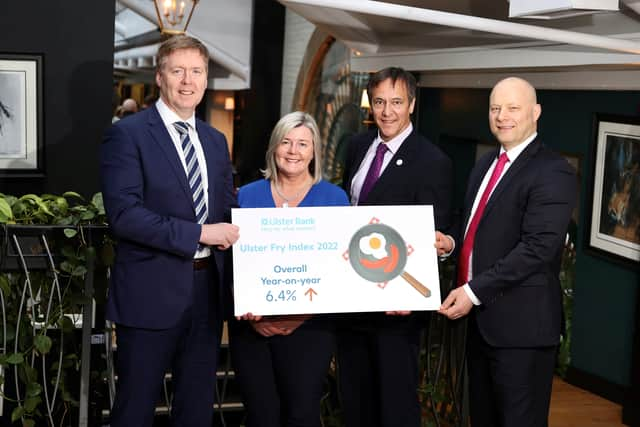Cost of living crisis - Expect food, fuel and energy prices to increase
and live on Freeview channel 276
This was the message at an event hosted by Ulster Bank this morning, ahead of its sponsorship of this year’s Balmoral Show.
And, it was revealed the Ulster Bank Ulster Fry Index is at its highest since 2014.
Advertisement
Advertisement
Overall, the Ulster Bank Ulster Fry Index – the average inflation rate of the items included - rose by a robust 6.4 per cent in the past year, meaning that the index is at its highest level since March 2014. This was the peak of the Ulster Fry Index and coincided with another cost of living crisis.


During the annual briefing, held in Stock Kitchen, above St. George’s Market, senior figures from within the bank outlined a number of key issues facing the local agri-food sector and reaffirmed Ulster Bank’s commitment to supporting the industry.
Ulster Bank Senior Agriculture Manager, Cormac McKervey, and the bank’s Chief Economist, Northern Ireland, Richard Ramsey, updated media, including members of the Guild of Agricultural Journalists, as well as other stakeholders, on the overall health of the local farming and food sectors and related economic issues.
They were joined by Ulster Bank Head of Northern Ireland, Mark Crimmins, who encouraged those in the audience to grasp the opportunities presented by a new, greener economy.
Advertisement
Advertisement
Mr Crimmins said: “The agri-food sector is a key pillar of the Northern Ireland economy, and we remain strongly committed to supporting it through the many challenges it currently faces.


“In particular, we want to work in partnership with the sector to tackle climate change and provide the tools and expertise agri-businesses need to fulfil their green ambitions.
“As a leading financier of renewable energy projects, we have recently launched two new green propositions including green loans and green asset finance options for qualifying SMEs.
“All of our business managers now undergo specialist climate training and are now fully equipped to assist customers, including those in the agri-sector, on their sustainability journey.”
Advertisement
Advertisement
Cormac McKervey, Senior Agriculture Manager, Ulster Bank, added: “Undoubtedly, farmers in Northern Ireland are operating through very challenging times and the pace and scale at which input costs continue to rise is alarming.
“Farm gate prices for beef, lamb, grain, and milk are at an all-time high, but margins remain static and, in some cases, are actually lower than this time last year.
“Many farmers are having to manage their cash flow extremely carefully, and while profitability has yet to dip, certain sub-sectors of the industry are being exposed to greater risks.
“Pig farmers are facing the most significant impact with input costs rocketing and the price for pork falling throughout the year.
Advertisement
Advertisement
“Land prices remain strong, and the demand is still high, yet we expect the majority of farmers to adopt a holding position rather than look to expand, given the other budgetary pressures currently facing the sector.
“Perhaps when Tier 2 approvals are received, then we will see an increase in overall capital investment.”
At the event, Richard Ramsey presented his annual Ulster Bank Ulster Fry Index, which shows that the price of all items making up the cooked breakfast gauge rose in the year to the end of February, using the UK Retail Price Index (RPI).
Milk saw the biggest price increase in the index with a rise of 16.7 per cent in the 12 months.
Advertisement
Advertisement
There were also strong rises in the prices of a range of other items including eggs (8.2 per cent), butter (six per cent), mushrooms (7.1 per cent), bread (5.6 per cent) and sausages (4.3 per cent).
Since the last recession, in 2008, the Ulster Bank Ulster Fry Index has risen a whopping 29 per cent.
Richard Ramsey said the Ulster Fry Index contains a more important message this year than ever.
“Food makes up a significant proportion of household spending,” he explained.
Advertisement
Advertisement
“Food and drink is also a key sector of the Northern Ireland economy.
“So, understanding how the price of food items is changing gives us some insight into both the current state of consumer finances, and also some of the challenges facing the agri-food industry.”
Mr Ramsey continued: “The fact that we are now in a new cost of living crisis means that creating understanding of price rises and cost pressures and where they are coming from is essential.
“What the Ulster Fry Index is telling us is that the prices of everyday items like milk and bread are rising really strongly at a time whenever households are also having to contend with big rises in their household energy bills.
Advertisement
Advertisement
“The reality, though, is that the Ulster Fry Index is only going to go one way in the foreseeable future, and that is up.
“Given the surge in energy prices already, alongside the disruption to the global food supply-chain stemming from the war between Russia and Ukraine, the Ulster Fry Index is expected to experience double-digit inflation over the next 12 months.
“This would see the Ulster Fry Index hit a new record high.”
He added: “Exactly this time two years ago, we thought we were entering a food crisis.
Advertisement
Advertisement
“People were stockpiling food items in the expectation of supply shortages and empty shelves, despite repeated reassurances from the industry and politicians.
“The reality was that the food and retail sectors pulled out all the stops to keep the supply lines open and to keep us fed.
“Today, two years on, a new and worrying food crisis is on the cards for different reasons.
“Russia and Ukraine are two of the most important producers and exporters of agricultural commodities in the world.
Advertisement
Advertisement
“Overall, the two countries export one in eight of all calories traded worldwide.
“What Saudi Arabia is to oil, Ukraine and Russia are to cereal crops.
“And don’t forget that cereal crops aren’t just a direct source of food, they are also a major indirect source of food in that they are fed to the livestock that we then consume.
“Food supply problems will further fuel economic nationalism due to the scramble for food security, meaning the further unwinding of globalisation, or de-globalisation.
Advertisement
Advertisement
“Indeed, such is the concern about the supply of food that countries are now hoarding and stockpiling by banning exports,” Mr Ramsey concluded.
Further information about the Ulster Fry Index is available at www.ulstereconomix.com